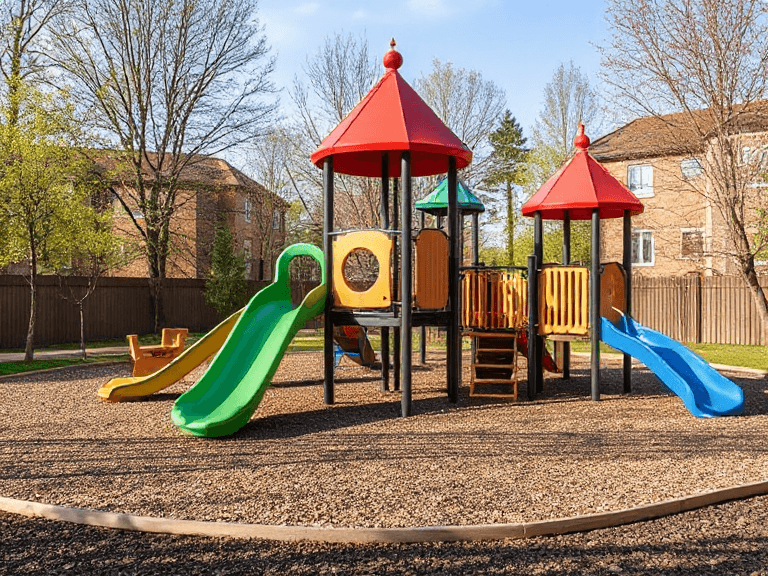By ZZ the HandyMan
Childhood is a time of boundless energy, unfiltered imagination, and a relentless desire to explore the world. Playgrounds act as magical realms where children can channel their energy, develop social skills, and foster physical growth. Creating a children’s playground is not just about assembling slides and swings; it’s about designing a space that ensures safety, stimulates creativity, and accommodates diverse needs. As a handyman with expertise in crafting functional and inspiring spaces, I’ll take you through the essentials of building the ultimate children’s playground.
The Importance of Playgrounds in Childhood Development
Playgrounds are more than recreational spaces; they are vital for a child’s mental, physical, and emotional growth. Here are just a few reasons why:
- Physical Development: Activities like climbing, swinging, and running improve motor skills, enhance coordination, and build muscle strength.
- Social Skills: Playgrounds encourage children to interact, cooperate, and build friendships. They learn the value of sharing and taking turns.
- Cognitive Growth: Imaginative play fosters problem-solving skills, decision-making abilities, and creativity.
- Emotional Well-being: Outdoor play reduces stress, improves mood, and helps children feel more connected to nature.
Essential Features of a Modern Playground
Modern playgrounds are evolving to be more inclusive, diverse, and stimulating. Here are the key elements every playground should have:
1. Safety First
- Surfacing: Opt for materials like rubber mulch, sand, or synthetic turf to cushion falls and prevent injuries.
- Equipment Standards: Use sturdy, weather-resistant materials and ensure all equipment meets safety standards.
- Design Considerations: Avoid sharp edges, small gaps where fingers can get trapped, and areas where children can fall from excessive heights.
2. Inclusive Design
Playgrounds should cater to children of all abilities. Add features like wheelchair-accessible ramps, sensory play areas, and tactile surfaces for visually impaired kids. Inclusivity ensures every child feels welcome and valued.
3. Age-Appropriate Zones
Divide the playground into sections catering to different age groups. For instance:
- Toddlers (1-3 years): Small slides, low climbing structures, and sensory play items like sandboxes.
- Preschoolers (4-6 years): Medium-sized climbing equipment, interactive games, and musical elements.
- Older Kids (7-12 years): Larger structures, monkey bars, zip lines, and challenging obstacle courses.
4. Interactive and Creative Play
- Install equipment that sparks creativity, such as playhouses, storytelling corners, or art walls.
- Include interactive features like musical panels, water play areas, or sand tables for sensory stimulation.
5. Natural Elements
Incorporate trees, shrubs, or even small gardens. Natural settings promote relaxation and teach children about the environment.
6. Ample Seating and Shade
Provide benches and shaded areas where parents can relax while keeping an eye on their children. Shade structures also protect kids from harmful UV rays.
Steps to Building a Playground
1. Planning and Budgeting
Start with a detailed plan. Determine the size of the space, the type of equipment needed, and the budget. Remember to allocate funds for long-term maintenance.
2. Choosing the Right Materials
Invest in high-quality, durable materials. Opt for eco-friendly options whenever possible, such as recycled plastics or sustainably sourced wood.
3. Engaging the Community
If the playground is for a school or public park, involve the community in the planning process. Conduct surveys to understand what parents and children want.
4. Installation
Follow manufacturer instructions closely and adhere to local safety regulations. If you’re not experienced with playground installations, hire professionals to ensure a secure setup.
5. Regular Maintenance
Inspect the playground regularly for wear and tear. Tighten loose bolts, repair damaged surfaces, and replace outdated equipment to keep the space safe and appealing.
DIY vs. Professional Installation
While some aspects of playground construction can be tackled as a DIY project, certain tasks are best left to professionals. For example:
- DIY-Friendly Tasks: Assembling swings, setting up sandboxes, or painting murals.
- Professional Tasks: Installing large climbing structures, ensuring ADA compliance, or laying specialized surfacing materials.
Trends in Playground Design
1. Adventure Playgrounds
These playgrounds allow children to take controlled risks, such as balancing on logs or climbing challenging structures, which builds resilience and confidence.
2. Themed Playgrounds
Incorporate themes like castles, space exploration, or pirate ships to make playtime more engaging and immersive.
3. Sustainable Playgrounds
Use recycled materials, solar-powered lighting, and natural landscaping to create eco-friendly play spaces.
4. Technology Integration
Add interactive games or apps that blend physical activity with digital elements for a modern touch.
Conclusion
Children’s playgrounds are much more than recreational spaces; they’re essential for holistic childhood development. Whether you’re a parent planning a backyard playground or a community leader designing a public park, remember that safety, inclusivity, and creativity are the cornerstones of a great playground. At ZZ the HandyMan, we’re passionate about creating spaces that bring joy and inspire growth. If you’re ready to turn your playground vision into reality, reach out to us today. Together, we can build a space where children’s imaginations soar and memories are made.


